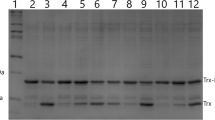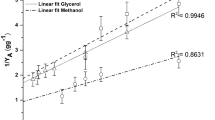Abstract
Pichia pastoris has emerged as a commercially important yeast for the production of a vast majority of recombinant therapeutic proteins and vaccines. The organism can be grown to very high cell densities using a defined basal salts media (BSM). However, BSM contains bi-cation or tri-cation phosphate, which precipitates out of the medium at pH above 5.5, although the optimal fermentation pH of most recombinant protein fermentation varies between 5.5 and 7.0. In this article, the application of glycerophosphates was investigated as a substitute phosphate source in an effort to eliminate precipitation. The solubility of BSM containing sodium or potassium glycerophosphates was examined before and after autoclaving at various pHs. Sodium glycerophosphate was found stable at autoclave temperature but formed complexes with coexisting magnesium and calcium ions that were insoluble above pH 7.0. Medium where sodium glycerophosphate was autoclaved separately and then added to the growth medium did not produce any precipitate up to pH 10.5. The performance of P. pastoris fermentations expressing α-galactosidase and ovine interferon-τ using a glycerolphosphate-based medium was found to be comparable to a conventional BSM. The results from this work demonstrate that sodium glycerophosphate can be assimilated by the P. pastoris strains and can be employed as a reliable phosphorus source for both cell growth and recombinant protein production.


Similar content being viewed by others
References
Curless C, Baclaski J, Sachdev R (1996) Phosphate glass as a phosphate source in high cell density Escherichia coli fermentations. Biotechnol Prog 12:22–25
Gancedo C, Gancedo JM, Sols A (1968) Glycerol metabolism in yeasts: Pathways of utilization and production. Eur J Biochem 5:165–172
Hayashi S, Koch JP, Lin ECC (1964) Active transport of L-a-glycerophosphate in Escherichia coli. J Biol Chem 239:3098–3106
Hellwig S, Robin F, Drossard J, Raven NPG, Vaquero-Martin C, Shively JE, Fischer R (1999) Production of carcinoembryonic antigen (CEA) N-A3 domain in Pichia pastoris by fermentation. Biotechnol Appl Biochem 30:267–275
Hellwig S, Emde F, Raven NPG, Henke M, Van der Logt P, Fischer R (2001) Analysis of single-chain antibody production in Pichia pastoris using on-line methanol control in fed-batch and mixed-feed fermentations. Biotechnol Bioeng 74:344–352
Johnson TM, Holaday SK, Sun Y, Subramaniam PS, Johnson HM, Krishna NR (1999) Expression, purification, and characterization of interferon-τ produced in Pichia pastoris grown in a minimal medium. J Interferon Cytokine Res 19:631–636
Laroche Y, Storme V, De Meutter J, Messens J, Lauwereys M (1994) High-level secretion and very efficient isotopic labeling of tick anticoagulant peptide (TAP) expressed in the methylotrophic yeast, Pichia pastoris. Biotechnology (NY) 12:1119–1124
Sinha J, Plantz BA, Zhang W, Gouthro M, Schlegel VL, Liu C-P, Meagher MM (2003) Improved production of IFN-τ by Mut+ strain of Pichia pastoris using an optimized methanol feed profile. Biotechnol Prog 19:794–802
Zamost BL (2001) Method for producing proteins in transformed Pichia. US patent 6,258,559
Zhang W, Bevins MA, Plantz BA, Smith LA, Meagher MM (2000) Modeling Pichia pastoris growth on methanol and optimizing the production of a recombinant protein, the heavy-chain fragment C of botulinum neurotoxin, serotype A. Biotechnol Bioeng 70:1–8
Zhang W, Sinha J, Smith LA, Inan M, Meagher, MM (2005) Maximizing secreted production of recombinant proteins in Pichia pastoris fed-batch fermentation. Biotechnol Prog 21:386–393
Zhu A, Monahan C, Zhang Z, Hurst R, Leng L, Goldstein J (1995) High-level expression and purification of coffee bean alpha-galactosidase produced in the yeast Pichia pastoris. Arch Biochem Biophys 324:65–70
Author information
Authors and Affiliations
Corresponding author
Rights and permissions
About this article
Cite this article
Zhang, W., Sinha, J. & Meagher, M.M. Glycerophosphate as a phosphorus source in a defined medium for Pichia pastoris fermentation. Appl Microbiol Biotechnol 72, 139–144 (2006). https://doi.org/10.1007/s00253-005-0238-9
Received:
Revised:
Accepted:
Published:
Issue Date:
DOI: https://doi.org/10.1007/s00253-005-0238-9




